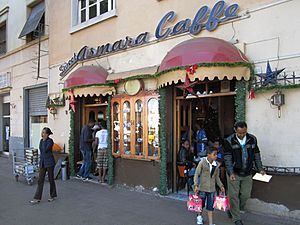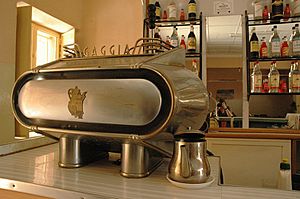Eritrean cuisine facts for kids
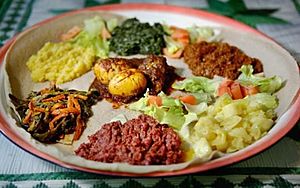
Eritrean cuisine is the traditional food of Eritrea. It mixes local cooking styles with ideas from other places. The food is similar to that of neighboring Ethiopia and other African countries in the region.
Contents
What is Eritrean Food Like?
Eritrean food shares many things with its neighbors. But it also has its own special touches.
The main traditional dish is tsebhi, which is a stew. It is served with injera, a flatbread. Injera is made from teff, wheat, or sorghum. Another common item is hilbet, a paste made from legumes like lentils and faba beans.
A typical Eritrean meal includes injera with a spicy stew. This stew often has beef, goat, lamb, or fish.
Eritrean food is quite similar to Ethiopian food. However, Eritrean cooking uses more seafood. This is because Eritrea is located along the coast. Eritrean dishes are also often lighter. They use less seasoned butter and spices. Instead, they use more tomatoes, like in tsebhi dorho.
Because Eritrea was once an Italian colony, its food also has Italian influences. You might find more pasta dishes. They also use more curry powders and cumin. People in Eritrea often drink coffee. Some Eritreans also drink sowa, a bitter fermented barley drink. Mies is a fermented honey drink.
Common Dishes and How They Are Eaten
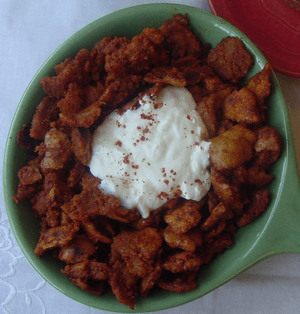
When eating injera, people usually share food from a large tray. This tray is placed in the middle of a low table. Many pieces of injera are laid out on the tray. Various spicy stews are then placed on top. Diners tear off pieces of injera from their section. They use these pieces to scoop up the stews.
The stews served with injera are often made from beef, chicken, lamb, goat, or vegetables. Most Eritreans enjoy spicy and hot food. Berbere is a special spice mix. It contains many common and unusual herbs and spices. Berbere is used in almost all dishes. Some stews include zigni, made with beef. Dorho tsebhi is made with chicken. Alicha is a vegetable dish made without berbere. Shiro is a thick purée made from different legumes.
When making ga'at, a special porridge, a spoon is used to make a dip in the middle. This dip is filled with a mix of berbere and melted butter. Milk or yogurt surrounds it. When eating, a small piece of ga'at is dipped into the berbere and butter sauce. Then it is dipped into the milk or yogurt.
Eritrean food also has unique versions of classic Italian dishes. This is due to its past as an Italian colony. For example, you can find pasta sauces spiced with berbere.
Breakfast Foods
- Kitcha fit-fit: This dish is made from pieces of a thick pancake. These pieces are tossed in clarified butter and spices. The pancake is often made from different flours or dry porridge. It is usually served for breakfast with yogurt or sour milk.
- Fit-fit: This dish uses torn pieces of injera. It is often mixed with leftover stew. It can also be made with onions, berbere, tomatoes, jalapeños, and butter. It is also called fir-fir.
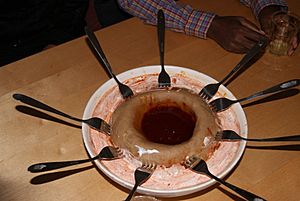
- Ga'at or akelet: This is a porridge made from flour and water. It is served in a bowl with a dip in the center. This dip holds clarified butter and berbere. Yogurt is usually placed around the sides. It is similar to other thick African porridges like ugali and fufu.
- Shahan ful: This dish features cooked and mashed fava beans. It is served with onions, tomatoes, jalapeños, cumin, yogurt, and olive oil. People usually eat it by dipping pieces of bread into the bean mixture.
- Panettone: Because of Italian influence, this sweet bread is often served with tea. It is also enjoyed during the coffee ceremony.
Lunch and Dinner Dishes
Most common Eritrean lunch and dinner dishes are stews. They can be meat-based or vegetable-based. These stews are always served over injera, the spongy flatbread.
- Tsebhi/Zigni: A spicy stew made with lamb, mutton, beef cubes, or ground beef and berbere.
- Dorho: A spicy stew made with berbere and a whole chicken.
- Qulwa/Tibsi: Sautéed meat, onions, and berbere served with a sauce.
- Alicha: A dish made without berbere. It includes potatoes, green beans, carrots, green peppers, and turmeric.
- Shiro: A stew made from ground chickpea flour, onions, and tomatoes.
- Birsen: Lentils, often cooked with onions, spices, and tomatoes. This stew can be made with or without berbere.
- Hamli: Sautéed spinach, garlic, and onions.
Drinks
Suwa is a homemade beer popular in Eritrea. It is made from roasted corn, barley, and other grains. It gets its flavor from gesho, a type of buckthorn leaf. This drink is often made for celebrations. A sweet honey wine called mies is also commonly served.
The coffee ceremony is a very important part of Eritrean culture. Coffee is offered when you visit friends. It is also served during parties or as a daily drink. If someone politely declines coffee, tea (shahee) will likely be offered instead.
Eritrea has a long history of coffee drinking. However, Italian-style coffee like espresso and cappuccino are also very common. You can find them in almost every bar and coffee shop in the capital city, Asmara.
The largest brewery in Eritrea is Asmara Brewery. It was built in 1939. Today, it makes many different drinks. A popular drink for celebrations is Eritrean-style Sambuca. In the Tigrinya language, it is called areki.
Italian-Eritrean Dishes
- Lasagna (Eritrean style)
- Cotoletta alla milanese (Milano cutlet)
- Capretto (young goat meat)
- Spaghetti Bolognese (Pasta with meat sauce and berbere)
- Frittata (Italian omelet)
- Panettone (sweet bread)
- Pasta Al forno (baked pasta)
- Pizza
- Gelato (Italian ice cream)
- Panna cotta (cooked cream dessert)
See also
 In Spanish: Gastronomía de Eritrea para niños
In Spanish: Gastronomía de Eritrea para niños


